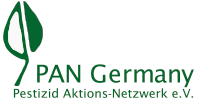
sind Gifte, die dazu bestimmt sind, lebende Organismen zu schädigen oder abzutöten.
Pestizide schaden aber nicht nur den Organismen, die sie bekämpfen sollen. Pestizide schädigen auch Nützlinge, verunreinigen Gewässer und führen zu Vergiftungen und schwerwiegenden Krankheiten bei Menschen.
mehr
21. Oktober 2019 · Rubrik: Pestizide
Brussels, Hamburg, 17.10.2019. Press release. A new review of carcinogenicity assessments of pesticide active ingredients shows 40 percent of them are not carried out in compliance with existing European guidelines, leading to possible continued exposure of farmers and consumers to cancer-causing pesticides [1]. In 30 percent of the cases significant details were missing from the dossiers, raising uncertainties about how European authorities came to a conclusion.
The report ‘Chronically underrated – A review of the EU carcinogenic hazard assessment of 10 pesticides’, released today by Pesticide Action Network (PAN) Germany and the Health and Environment Alliance (HEAL) analysed the carcinogenicity sections of the draft Renewal Assessments Reports (RARs) of ten pesticides [2]. The review, performed by senior toxicologist Peter Clausing, focused on how the sections describing carcinogenicity studies in rats and mice in the EU assessment documents complied with the applicable guidelines and guidance documents of the EU and the Organisation for Economic Co-operation and Development (OECD).
“After discovering a considerable number of flaws in the carcinogenicity assessment of glyphosate, it was the logical next step to investigate whether similar problems occurred with other pesticides. Analysing these ten RARs has made it clear that at least three of the pesticides should have been classified as ‘presumed’ human carcinogens, rather than just ‘suspected’ human carcinogens”, explained Susan Haffmans, Senior Advisor on Pesticides at PAN Germany.
The carcinogenicity classification triggers the regulatory fate of a pesticide active ingredient. Pesticides classified as ‘suspected’ human carcinogens can be marketed, while those classified as ‘presumed’ human carcinogens cannot or must be withdrawn [3].
Our report shows that:
– For three pesticides, the outcome of our review was similar to that of the European authorities: chlorothalonil, diuron, forchlorfenuron;
– For three pesticides, the outcome of our review differed from that of the European authorities and we found that the classification should be upgraded: folpet, pirimicarb and thiacloprid;
– For one pesticide, our review found that severe data gap should have been identified by the European authorities and a flawed decisive carcinogenicity should not have been accepted: phosmet;
– For three pesticides, our review found that reports were not sufficiently informed to allow any conclusive external review: captan, chlorpropham, dimoxystrobin.
“The current rise of non-communicable diseases including cancer means that Europe cannot afford the health price of flawed pesticides classifications”, commented Genon K. Jensen, Executive Director of the Health and Environment Alliance (HEAL). “Committing to a rigorous implementation of European laws should be a founding block of reaching Europe’s zero-pollution objective to prevent diseases and protect people, starting with farmers, from substances toxic to their health.”
PAN Germany and HEAL call on the European Commission President-elect Ursula von der Leyen to pay particular attention to a more rigorous application of existing pesticide legislation and guidance documents. In her recent confirmation hearing at the European Parliament, the Commissioner-designate for Health Stella Kyriakides already agreed Europe needs to reduce dependency on pesticides and stimulate the take-up of low-risk and non-chemical alternatives [4].
Contact:
Dr. Peter Clausing, Executive board member Pesticide Action Network (PAN) Germany, peter.clausing@pan-germany.org
Yannick Vicaire, Chemicals and Health Policy campaigner Health and Environment Alliance (HEAL) , yannick@env-health.org
Notes to editor:
[1] Chronically Underrated, Peter Clausing, October 2019.Other publications on this topic from Dr. Peter Clausing include:
– Clausing et al. (2018): Pesticides and public health: a review of the regulatory approach to assessing the carcinogenicity of glyphosate in the European Union. J. Epidemiol. Community Health 72, 668–672
– Pesticide Action Network Europe (2018): Ensuring a higher level of protection from pesticides in Europe
The Pesticide Action Network Germany (PAN Germany) is a nongovernmental organisation informing about the negative consequences of pesticide use and promoting environment-friendly and socially fair alternatives. PAN Germany is part of the PAN International network. Our work comprises critical analyses of pesticides and their use, policy advice practical advice for farmers and consumers.
The Health and Environment Alliance (HEAL) is the leading not-for-profit organisation addressing how the environment affects human health in the European Union (EU) and beyond. HEAL works to shape laws and policies that promote planetary and human health and protect those most affected by pollution, and raise awareness on the benefits of environmental action for health.

Datum: 21. Oktober 2019 289.03 KB
This report, commissioned by Pesticide Action Network (PAN) Germany and by the Health and Environment...
Datum: 21. Oktober 2019 80.39 KB
Glyphosate, one of the world’s most widely used pesticides that has been linked to multiple negative...
Datum: 21. Oktober 2019 88.71 KB
Glyphosat, eines der meistverwendeten Pestizide der Welt, das mit verschiedenen negativen Auswirkungen...
Datum: 21. Oktober 2019 273.16 KB
El glifosato, uno de los pesticidas más utilizados en el mundo y que ha sido relacionado con múltiples...